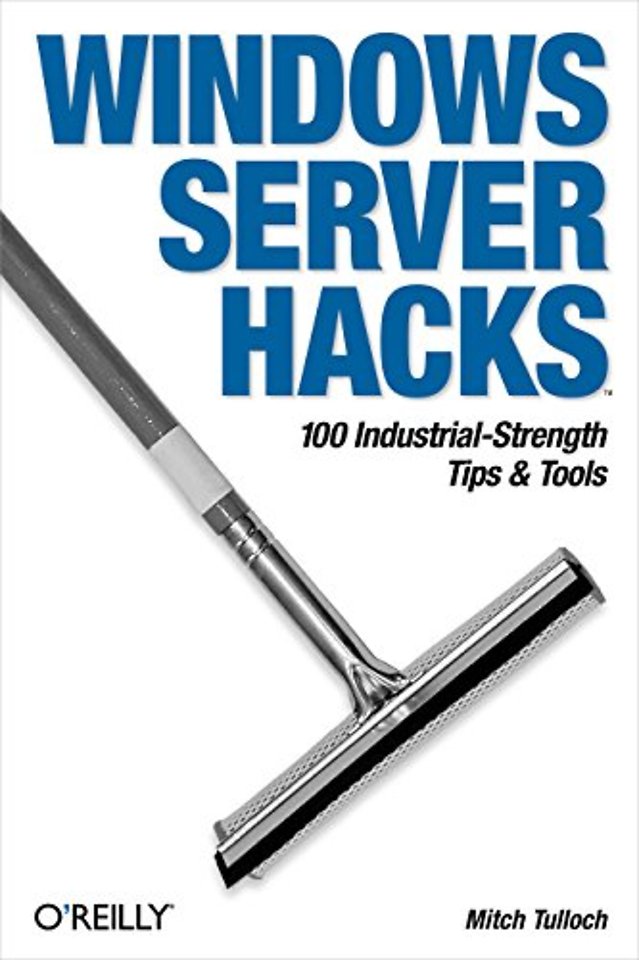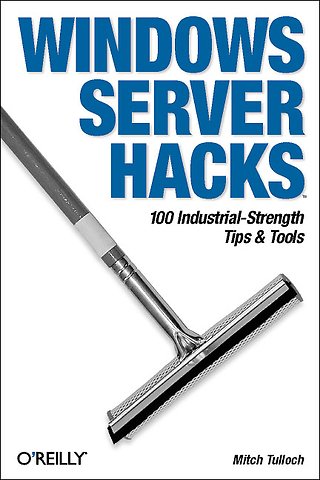Windows Server Hacks
Paperback Engels 2004 9780596006471Samenvatting
One of the secrets to the ever-increasing popularity of Windows Server can be found in the simplicity its administration. The easy-to-use GUI, consistent set of tools, and wizards that walk you through complex tasks allow you to install, configure and maintain Windows servers without any knowledge of programming or scripting languages or learning complicated command-line syntax. It's possible, in fact, to accomplish about 90% of all Windows administration without ever opening a command prompt or running a script!But what about the other ten percent of the time While it's true that most common, day-to-day tasks of Windows administration can be performed from the GUI, it's not always the best way, especially with complex or repetitive tasks Scripts and command-line tools often provide a faster, more flexible approach. Windows Server Hacks reveals techniques that go well beyond basic management tasks found in most handbooks to help busy system administrators master the more powerful features of Windows Server.Windows Server Hacks focuses on scripts and other tools that will make your life as an administrator much easier. These tools, or hacks--quick and dirty solutions to problems, or clever ways of doing things--were created by other professionals who've also had to struggle to find solutions to administering Windows environments. You'll save valuable time using their scripts, tools, tips, and advice. Plus, you can easily learn to customize the scripts to create even more powerful tools for your own, specific needs.The book includes secrets of the masters in such areas as Active Directory, User Management, Group Policy, DNS and DHCP, File and Print, IIS, performance and security. The hundred, industrial strength hacks in the book range from those that deal with general administration to more esoteric hacks in the areas of network deployment, patch management, and backup and recovery.No matter which Windows server you use--NT, IIS, 2000, or 2003--this book will put the knowledge and expertise of veteran system administrators and hackers to work for you. Windows Server Hacks will make your life easier while expanding your understanding of the capabilities of Windows Server.
Specificaties
Lezersrecensies
Inhoudsopgave
About the Author;
Contributors;
Acknowledgments;
Foreword: I’m a Sci-Fi freak;
Preface;
Why Windows Server Hacks?;
Getting and Using the Scripts;
How to Use This Book;
How This Book Is Organized;
Conventions Used in This Book;
Using Code Examples;
How to Contact Us;
Got a Hack?;
Chapter 1: General Administration;
1.1 Hacks #1-16;
1.2 Use Run As to Perform Administrative Tasks;
1.3 Drag and Drop to the Run Menu;
1.4 Find and Replace Registry Keys from a Command Line;
1.5 Automatically Log On After Booting;
1.6 Wait for and Optionally Terminate a Process;
1.7 Shut Down a Remote Computer;
1.8 Rename Mapped Drives;
1.9 Execute a Command on Each Computer in a Domain;
1.10 Add, Remove, or Retrieve Environment Variables;
1.11 Extend Group Policy;
1.12 Disable EFS;
1.13 Get Event Log Information;
1.14 Shortcut to Remote Assistance;
1.15 Desktop Checker;
1.16 Top Five Tools;
1.17 myITforum.com;
Chapter 2: Active Directory;
2.1 Hacks #17-24;
2.2 Retrieve the List of Old Domain Computer Accounts;
2.3 Automate Creation of OU Structure;
2.4 Modify All Objects in the OU;
2.5 Delegate Control of an OU to a User;
2.6 Send OU Information in Active Directory to an HTML Page;
2.7 Display Active Directory Information;
2.8 Store and Display Contact Information in Active Directory;
2.9 Restore the Active Directory Icon in Windows XP;
Chapter 3: User Management;
3.1 Hacks #25-35;
3.2 Search for Domain Users;
3.3 Manage User Accounts in Active Directory;
3.4 Get a List of Disabled Accounts;
3.5 Get User Account Information;
3.6 Check for Passwords that Never Expire;
3.7 Enumerate Group Membership to a CSV File;
3.8 Modify User Properties for All Users in a Particular OU;
3.9 Check Group Membership and Map Drives in a Logon Script;
3.10 Script Creation of a User’s Home Directory and Permissions;
3.11 Prevent Ordinary Users from Creating Local Accounts;
3.12 Put a Logoff Icon on the Desktop;
Chapter 4: Networking Services;
4.1 Hacks #36-47;
4.2 Manage Services on Remote Machines;
4.3 Simplify DNS Aging and Scavenging;
4.4 Troubleshoot DNS;
4.5 Manually Recreate a Damaged WINS Database;
4.6 Change WINS for All Enabled Adapters;
4.7 Ensure DHCP Server Availability;
4.8 Change a Network Adapter’s IP Info;
4.9 Change from Static IP to DHCP;
4.10 Release and Renew IP Addresses;
4.11 Use netsh to Change Configuration Settings;
4.12 Remove Orphaned Network Cards;
4.13 Implement Windows 2000 Network Load Balancing;
Chapter 5: File and Print;
5.1 Hacks #48-53;
5.2 Map Network Drives;
5.3 Determine Who Has A Particular File Open on the Network;
5.4 Display a Directory Tree;
5.5 Automate Printer Management;
5.6 Set the Default Printer Based on Location;
5.7 Add Printers Based on Name of Computer;
Chapter 6: IIS;
6.1 Hacks #54-61;
6.2 Back Up the Metabase;
6.3 Restore the Metabase;
6.4 Map the Metabase;
6.5 Metabase Hacks;
6.6 Hide the Metabase;
6.7 IIS Administration Scripts;
6.8 Run Other Web Servers;
6.9 IISFAQ;
Chapter 7: Deployment;
7.1 Hacks #62-68;
7.2 Get Started with RIS;
7.3 Customize RIS;
7.4 Tune RIS;
7.5 Customize SysPrep;
7.6 Remove Windows Components from the Command Line;
7.7 Unattended Installation of Windows Components;
7.8 Easily Create a Network Boot Disk;
Chapter 8: Security;
8.1 Hacks #69-78;
8.2 Fundamentals of a Virus-Free Network;
8.3 Antivirus FAQ;
8.4 Rename the Administrator and Guest Accounts;
8.5 Get a List of Local Administrators;
8.6 Find All Computers that Are Running a Service;
8.7 Grant Administrative Access to a Domain Controller;
8.8 Secure Backups;
8.9 Find Computers with Automatic logon Enabled;
8.10 Security FAQ;
8.11 Microsoft Security Tools;
Chapter 9: Patch Management;
9.1 Hacks #79-89;
9.2 Best Practices for Patch Management;
9.3 Beginners Guide to Enterprise Patch Management;
9.4 Patch-Management FAQ;
9.5 Enumerate Installed Hotfixes;
9.6 Apply Patches in the Correct Order;
9.7 Windows Update FAQ;
9.8 Obtain Updates via the Windows Update Catalog;
9.9 Use Automatic Updates Effectively;
9.10 Use Group Policy to Configure Automatic Updates;
9.11 Automatic Updates FAQ;
9.12 Software Update Services FAQ;
Chapter 10: Backup and Recovery;
10.1 Hacks #90-100;
10.2 Collect Disaster Recovery Files;
10.3 Back Up Individual Files from the Command Line;
10.4 Back Up System State on Remote Machines;
10.5 Back Up and Restore a Certificate Authority;
10.6 Back Up EFS;
10.7 Work with Shadow Copies;
10.8 Back Up and Clear the Event Logs;
10.9 Back Up the DFS Namespace;
10.10 Recover with Automated System Recovery;
10.11 Recovery Roadmap;
10.12 Data Recovery of Last Resort;
Colophon;
Rubrieken
- advisering
- algemeen management
- coaching en trainen
- communicatie en media
- economie
- financieel management
- inkoop en logistiek
- internet en social media
- it-management / ict
- juridisch
- leiderschap
- marketing
- mens en maatschappij
- non-profit
- ondernemen
- organisatiekunde
- personal finance
- personeelsmanagement
- persoonlijke effectiviteit
- projectmanagement
- psychologie
- reclame en verkoop
- strategisch management
- verandermanagement
- werk en loopbaan

